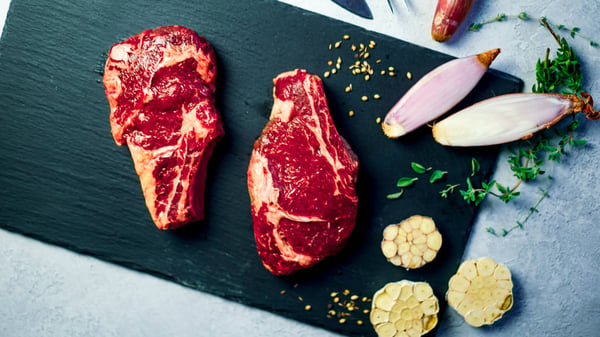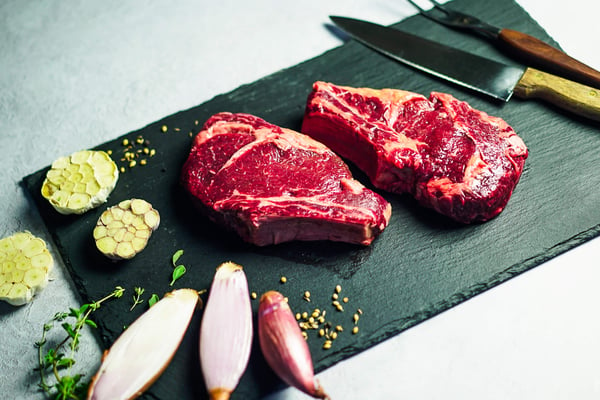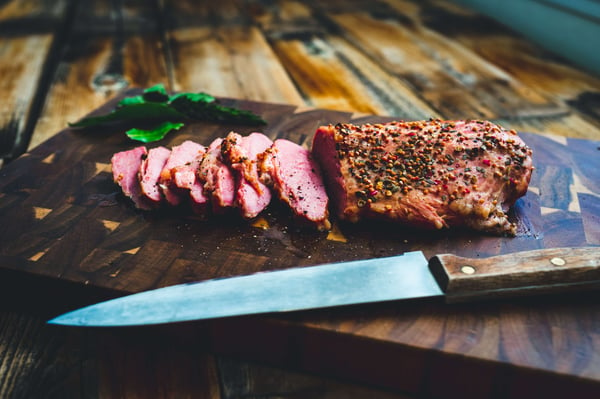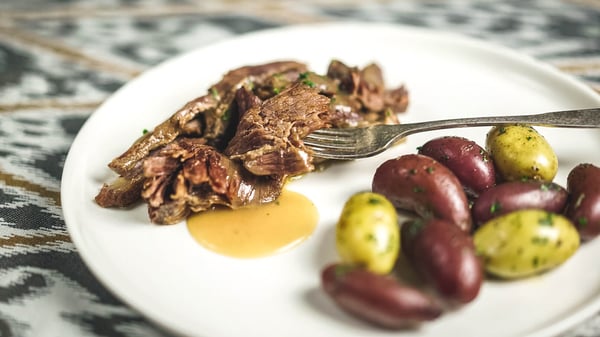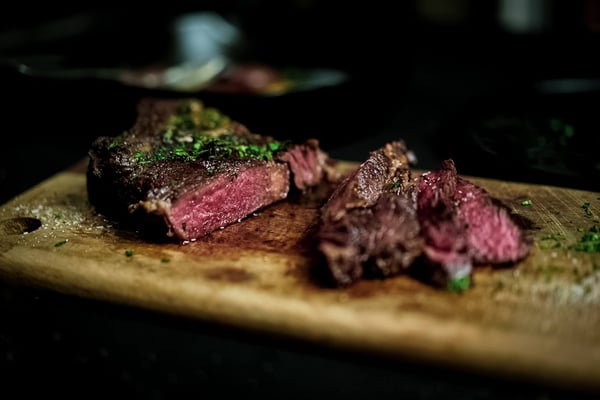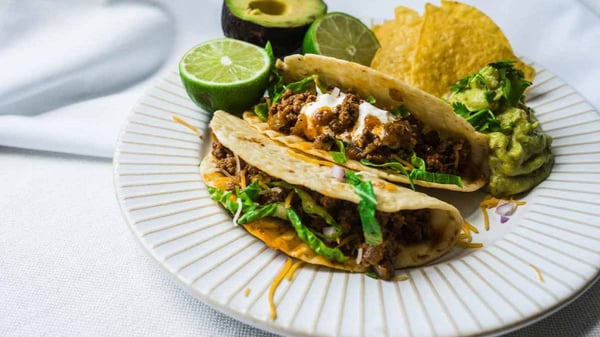
Welcome to our master guide on how to cook grassfed beef.
“How do I properly cook grassfed beef?” is a question we hear a lot at White Oak Pastures. We’re proud of the animals we raise on our pastures, the carbon-sequestering land management methods we use, and the products we produce for our customers. But we also recognize that grassfed beef is, quite literally, a different animal to cook with in the kitchen.
Our farm is committed to zero waste practices, meaning that any part of the animal we can't sell to customers, we turn into leather or tallow products, or we compost and return the nutrients to our soils.
Our focus on zero waste also includes helping our customers make the most out of every cut of meat they buy from us.
So here in our master guide, we will:
- Explain what sets grassfed beef apart
- Divide common grassfed beef cuts into categories based on our recommended cooking method (and tell you why)
- Link to sample recipes for each technique
Grassfed vs Grain Fed Beef
The life of one of our pasture-raised cattle is a complete contrast from the life of grain-fed, commodity feedlot cattle. As Brian Sapp, Director of Operations at White Oak Pastures, explains,
The marbling of beef dictates how we perceive the tenderness of the product. Higher marbled beef will be more tender than less marbled beef.
Typical commodity, corn-finished beef are usually confined to feedlot operations where movement is limited.
- The animals have feed and water brought to them, gaining weight faster, keeping muscle fiber structure smaller, and marbling well.
- Because of the accelerated timeline, these animals are slaughtered 6-8 months younger than pasture-raised beef.
- Even some cattle labelled as “grassfed” may still be raised on confined feedlots, fed hay and pre-grain silage but limited in movement so they gain weight faster, in order to make “cheap” grassfed beef.
Cattle raised on strictly forage (grass) are very active, which creates a leaner product with a different muscle fiber structure than commodity beef items.
- As pasture-raised animals have to move about to forage and access water, they burn calories and fat.
- This activity and diet means that grassfed beef tends to be leaner than commodity beef items.
Grassfed, grass finished beef
White Oak Pastures cows, raised on pasture and with plenty of natural exercise, have less marbling than commodity feedlot cattle. This is because of our commitment to the welfare of our animals, who were born to roam and graze. Our grassfed beef comes from animals who were raised on pasture, as they were intended to.
This means that some prep work and cooking alterations should be made to maximize the tenderness of our product. Done right, the flavor is unbeatable.
How to Make Tender Grassfed Beef
Here, we break down some broad categories of cuts of grassfed beef that benefit from similar cooking techniques. For each category, we explain our recommended cooking method and include a recipe you can try.
If you're new to some of these cuts, these recipes are a great starting point. If you're a grassfed beef connoisseur, we hope some of these recipes will provide new inspiration.
How To Perfectly Cook Grassfed Beef, By Cut
Click below to skip to a section or scroll down:
- Slow Cook: large cuts like Chuck Roast, Shoulder Roast, Bottom Round Steak
- Braise: cuts like Bone-In Short Ribs, Stew Beef
- Age and Sear: steaks like Ribeye Steak, Tenderloin Steak, Strip Steak, Sirloin Steak
- Tenderize and Marinate: London Broil, Some Steaks, Stir Fry, Skirt Steak
- Any Method You Want: Ground Beef
Slow Cook: large cuts like Chuck Roast, Shoulder Roast, Bottom Round Steak
Roasts are relatively large cuts of meat from muscles that the animal used a lot when walking (like legs and shoulders). These cuts have lots of connective tissue, like ligaments and tendons, that the animal uses to move around.
To break down the connective tissue, it's best to cook these cuts slowly, for long periods of time, under wet heat. Cooking "low and slow" in a slow cooker or Instant Pot does two things:
- Breaks down the muscle fibers so they are falling-apart tender
- Liquifies the fat and collagen, allowing them to coat the muscle fibers, adding rich and deep flavor
The result? A moist, tender, delicious roast.
For grassfed beef roasts, try these recipes:
- Versatile beef chuck roast
- Tender & Juicy Instant Pot Beef Roast
- Slow-cooked corned beef and cabbage
Braise: cuts like Bone-In Short Ribs, Stew Beef
Alright, you caught us—"slow cooking" and "braising" are basically the same method: cook low and slow, with wet heat. However, we recommend cooking the large roasts and the smaller cuts a little differently.
Large roasts do well in a slow cooker, becoming tender and breaking down with a little bit of liquid and their own juices. For the smaller cuts, like short ribs and stew beef, we recommend almost submerging them in liquid completely. Braising these cuts uses flavorful stock and aromatics to slow cook them until they're so tender, you could eat them with a spoon.
For smaller grassfed beef roast cuts, try this recipe:
Age and Sear: steaks like Ribeye Steak, Tenderloin Steak, Strip Steak, Sirloin Steak
If you were to take a fresh ribeye out of our Cutting Room and cook it without tenderizing it properly, it would most likely result in a tough steak. “How to cook a grassfed steak” is one of the top questions we get at White Oak Pastures, so we’ve devoted a lot of time breaking down the process.
Particularly for grassfed steaks, we recommend aging the meat. Aging meat not only creates a more complex flavor, but it will also tenderize the meat and make it harder to overcook on the grill or stovetop. However, if aging isn’t your thing, you can also use an alternative tenderizing method (see below) before cooking your steak.
For grassfed beef steaks, try this recipe:
Tenderize and Marinate: London Broil, Some Steaks, Stir Fry, Skirt Steak
For a lean piece of flank meat like a London Broil or some steaks, a combination of tenderizing the meat by hand and marinating before cooking will ensure a moist, delicious product.
We go over some of our favorite ways to tenderize our grassfed beef in more detail in this blog post.
After you tenderize your meat, marinating it for a few hours will add flavor and richness to the meat. Use acidic ingredients like lemon juice, vinegar, or buttermilk to give the meat a "pre-cook" before you prepare it. To avoid over-softening the meat, we recommend limiting the marinade time to 30 minutes - 2 hours.
For our stir fry beef, the small pieces don't need to be tenderized, but we do recommend marinating them before cooking!
For grassfed beef cuts that need some tenderization, try this recipe:
Any Method You Want: Ground Beef
Grassfed ground beef doesn't differ much in texture from any other kind of ground beef. Our classic grassfed ground beef uses 90% meat to 10% fat ratio, which is standard proportion for most ground beef. We do believe our grassfed ground beef has a superior flavor, and it goes especially well with warm, smoky herbs and spices.
We recommend using our grassfed ground beef for burgers, meatballs, chili, tacos, and any other of your favorite ground beef recipes.
For grassfed ground beef, try this recipe:
Other External Resources on Grassfed Beef:
- Grilling steaks: How to Cook the Perfect, Tender, Grass Fed Steak (Shannon Hayes)
- Dry brining steaks: How To Cook Perfectly Tender Grass-Fed Steak (Primally Inspired)
- Cast iron cooking: How to Cook the Perfect Steak in a Cast-Iron Skillet (The Rising Spoon)
- General guide: Cooking With Grass-Fed Beef (Whole Foods)

